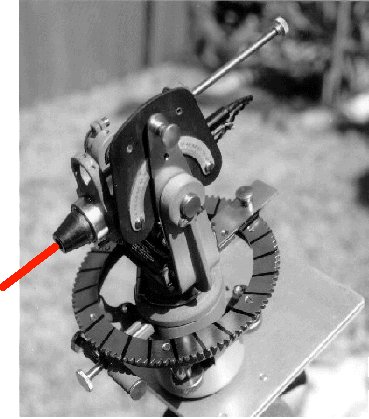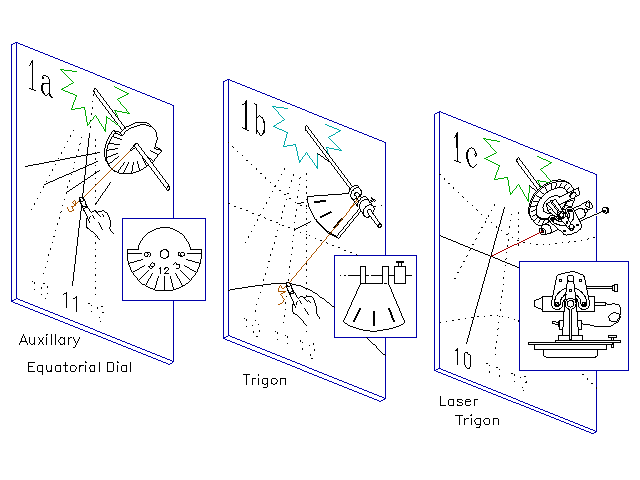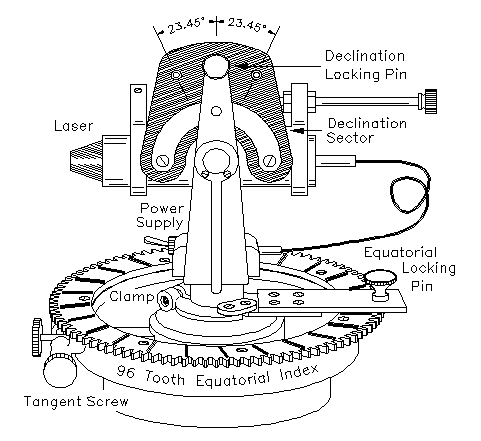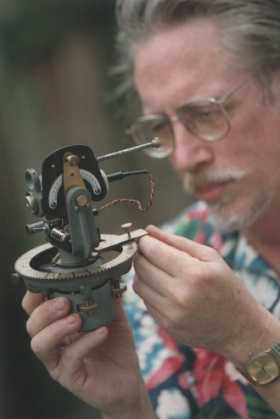Mechanical Dialing and a Laser Trigon
 By Robert Terwilliger
By Robert TerwilligerThe most popular ways to lay out sundials involves computation, geometry, or a combination of both. These methods assume the dial will be created on a regular surface, such as flat horizontal or vertical dials or circularly curved equatorial dials.
A less known method is mechanically drawing dial lines using a string or laser beam to project artificial “sunbeams” to show where light and shadow fall. This technique can be used on both regular and irregular surfaces. We start by describing the principles of a trigon.
Imagine a protractor with equally marked hour lines held on the polar axis (an axis aligned with the earth’s rotation). Allow a string to extend from the protractor onto a surface. (Figure 1a). At specific angles, we mark where the string hits the sundial surface. For example, every 15 degrees will mark an increase in one hour's time.

The protractor can also be placed in line with the polar axis (Figure 1b). Here we let the string angle stay fixed (say +23.5 degrees) but let the protractor swing around the polar axis. The string traces the diurnal (daily) path of a sunbeam.
The Laser Trigon (Figure 1c and shown in detail at right) combines both protractors and a laser light source instead of a string to draw both the hour lines and curves of the equinoxes and solstices.
The protractor of Figure 1a is called an auxiliary equatorial dial, and locates the hour lines at 15 degree increments. Half our lines can be obtained by offsetting the marks by 7.5 degrees and can be further subdivided into even finer fractional hours. In use, the disk is mounted at right angles to the gnomon, and rotated until it aligns with noon. When secured in this position it becomes an auxiliary equatorial dial.
The second protractor of Figure 1b is called a trigon. Historically the term trigon has been applied to a number of instruments that use triangles. The trigon is used to mark the sun's declination (sun’s distance north or south of the celestial equator) and is used to mark the solstice curves and equinox line on the dial face. The trigon is mounted on the gnomon with the protractor plane parallel to the axis of the gnomon. It must be mounted exactly at the a the node of the sundial gnomon (the notch on the gnomon that will cast a diurnal distinct shadow mark). Our illustrated trigon has three declinations (+23.5 degrees for summer solstice, -23.5 degrees for winter solstice, and 0 degrees for the equinoxes). Additional indication angles could be provided to locate the curves for all the signs of the Zodiac, or even special dates such as anniversaries or birthdays. Unlike the auxiliary equatorial dial which is fixed, the trigon is free to rotate, but its center must be kept at the node.
Laser Trigon Details

The Laser Trigon combines the two traditional tools in a modern instrument. The angles are no longer lined up by eye, but by mechanical gears, and the somewhat inexact science of extending a string is replaced with a very exact laser beam.
 It is probably obvious from the illustrations that the instrument was made out of a small transit. A transit is built with two axes of rotation at right angles to each other. These two axes correspond perfectly to those of the traditional dialing tools.
It is probably obvious from the illustrations that the instrument was made out of a small transit. A transit is built with two axes of rotation at right angles to each other. These two axes correspond perfectly to those of the traditional dialing tools.
In a transit, the principal axis of rotation is carefully maintained as horizontal. A transit is designed to measure horizontal angles. The telescope sweeps 360 degrees, and if the telescope is level, all points viewed through the cross-hairs are in the same horizontal plane.
Redesigned as a Laser Trigon, the transit's horizontal motion is aligned with the the earth's equatorial plane, thus the vertical axis of the transit aligns itself with the earth's polar axis. The transit's vertical motion, normally used to measure vertical angles, can now be fixed to angles relative to the polar axis, corresponding to the sun's declination.
The horizontal 360 degree circle on the transit was removed and replaced with a 96 tooth index gear. 96 teeth provide 24 fifteen degree segments for the hours, which are then subdivided into quarter hours. This provides an indexed auxiliary equatorial dial that controls the motion of the laser in the equatorial plane. A locking pin is provided so it can be secured at specific hour angles. With the vertical motion free, points can be located along the selected hour line. The half of the equatorial index that represents the nighttime hours will not normally be used, but having a full 24 hour equator available is handy for flexibility in mounting.
The arc for the 180 degree vertical motion of the transit is still in place, but a sectpr os added with a three position index corresponding to the declination. A locking pin here enables the laser to be secured at 90 degrees from the polar axis for the equinox, or 23.45 degrees in each direction for the solstice curves.
Finally, the transit telescope was removed and a small laser carefully aligned in a portion of the telescope tube. The laser was adapted from an ordinary laser pointer. A carrier for the batteries and off/on switch was mounted between the vertical arms of the transit. The laser does not make a mark, but simply projects a red dot onto the receiving surface.
Using the Laser Trigon
The Laser Trigon is most valuable for laying out the hour and seasonal lines for large and perhaps irregularly shaped sundials. The Laster Trigon is mounted with its axis aligned with the gnomon edge (the "style") and centered on the place of intended node. After securing the instrument in place, the equatorial index is aligned such that the noon time mark of the index matches the point on the sundial of solar noon. When the laser points to the noon line, the equatorial auxillary is clamped. With the 12:00 position set, the trigon can be rotated along the hour line and at successive laser light points, dots are marked on the dial surface.

To locate the solstices and equinox line, the equatorial locking pin is removed and the equatorial motion is free. The declination index is aligned with the hole in the sector corresponding to the desired line or curve and the declination locking pin inserted. The laser is free to rotate in the equatorial plane and can be moved across the dial face, pausing to locate as many points as required.
The principal advantage of the Laser Trigon is its ability to “paint” the required hour, solstice and equinox lines of a sundial on a highly irregular surface. This surface can be a natural formation, a combination of plane surfaces at random angles, a purposely designed sculpture, or a selected group of free-standing objects. Your imagination becomes the limit.
